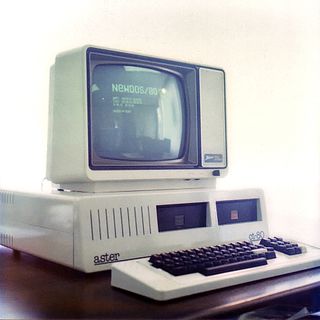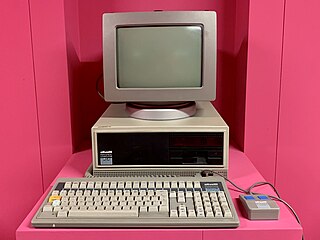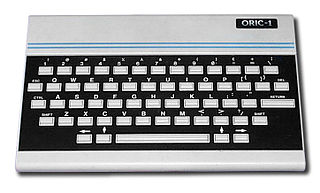Related Research Articles

The Aster CT-80 is a 1982 personal computer developed by the small Dutch company MCP, was sold in its first incarnation as a kit for hobbyists. Later it was sold ready to use. It consisted of several Eurocard PCB's with DIN 41612 connectors, and a backplane all based on a 19-inch rack configuration. It was the first commercially available Dutch personal/home computer. The Aster computer could use the software written for the popular Tandy TRS-80 computer while fixing many of the problems of that computer, but it could also run CP/M software, with a large amount of free memory Transient Program Area, (TPA) and a full 80×25 display, and it could be used as a Videotext terminal. Although the Aster was a clone of the TRS-80 Model I it was in fact more compatible with the TRS-80 Model III and ran all the software of these systems including games. It also had a built-in speaker which was compatible with such games software.

The Apple II is an early personal computer that was created by Apple Inc. It was one of the first successful mass-produced microcomputer products, and it played a significant role in the early development of the personal computer industry. It has an 8-bit microprocessor.

The Tandy 1000 is the first in a line of IBM PC compatible home computer systems produced by the Tandy Corporation for sale in its Radio Shack and Radio Shack Computer Center chains of stores. Introduced in 1984, the product line was aimed at providing affordable but capable systems for home computing or education, with some of its Tandy specific features like graphics, sound and joystick port making it more appealing for home use.

The Hercules Graphics Card (HGC) is a computer graphics controller formerly made by Hercules Computer Technology, Inc. that combines IBM's text-only MDA display standard with a bitmapped graphics mode, also offering a parallel printer port. This allows the HGC to offer both high-quality text and graphics from a single card.

The Enhanced Graphics Adapter (EGA) is an IBM PC graphics adapter and de facto computer display standard from 1984 that superseded the CGA standard introduced with the original IBM PC, and was itself superseded by the VGA standard in 1987. In addition to the original EGA card manufactured by IBM, many compatible third-party cards were manufactured, and EGA graphics modes continued to be supported by VGA and later standards.

The Apple IIGS is a 16-bit personal computer produced by Apple Computer. It is the fifth and most powerful of the Apple II family. It is compatible with earlier Apple II models but has a Macintosh look and feel, and resolution and color similar to the Amiga and Atari ST. The "GS" in the name stands for "Graphics and Sound", referring to its enhanced multimedia hardware, especially its state-of-the-art audio.

The SAM Coupé is an 8-bit British home computer manufactured by Miles Gordon Technology (MGT), based in Swansea in the United Kingdom and released in December 1989.

The Color Graphics Adapter (CGA), originally also called the Color/Graphics Adapter or IBM Color/Graphics Monitor Adapter, introduced in 1981, was IBM's first color graphics card for the IBM PC and established a de facto computer display standard.

The FM Towns is a Japanese personal computer built by Fujitsu from February 1989 to the summer of 1997. It started as a proprietary PC variant intended for multimedia applications and PC games, but later became more compatible with IBM PC compatibles. In 1993, the FM Towns Marty was released, a game console compatible with existing FM Towns games.

The FM Towns Marty is a fifth-generation home video game console released in 1993 by Fujitsu, exclusively for the Japanese market. It is often claimed to be the first 32-bit CD-based home video game system, although it has a 16-bit data bus, just like the earlier Commodore CDTV and Sega CD, which both have Motorola 68000 processors that are similar internally 16/32-bit, but with a 16-bit data bus. The console came complete with a built-in CD-ROM drive and disk drive. It was based on the earlier FM Towns computer system Fujitsu had released in 1989. The Marty was backward-compatible with older FM Towns games.

Professional Graphics Controller is a graphics card manufactured by IBM for PCs. It consists of three interconnected PCBs, and contains its own processor and memory. The PGC was, at the time of its release, the most advanced graphics card for the IBM XT and aimed for tasks such as CAD.

The Plantronics Colorplus is a graphics card for IBM PC computers, first sold in 1982. It implements a superset of the then-current CGA standard, using the same monitor standard and providing the same pixel resolutions. It was produced by Frederick Electronics, a subsidiary of Plantronics since 1968, and sold by Plantronics' Enhanced Graphics Products division.

The ATM Turbo, also known simply as ATM is a ZX Spectrum clone, developed in Moscow in 1991, by two firms, MicroArt and ATM.

The IBM 3270 PC, released in October 1983, is an IBM PC XT containing additional hardware that, in combination with software, can emulate the behaviour of an IBM 3270 terminal. It can therefore be used both as a standalone computer, and as a terminal to a mainframe.

The Apple II Plus is the second model of the Apple II series of personal computers produced by Apple Computer. It was sold from June 1979 to December 1982. Approximately 380,000 II Pluses were sold during its four years in production before being replaced by the IIe in 1983.
The Kay 1024 was a Russian ZX Spectrum clone introduced in 1998. Created by the NEMO company of St. Petersburg, it has 1024 KB of RAM. It was a rival to Scorpion ZS 256, having a slightly lower price. It offered a controller for a PC keyboard and HDD, but not for floppy disks. Adding a General Sound card was easy, and the CPU had a 7 Mhz turbo mode.

The Olivetti M24 is a computer that was sold by Olivetti in 1983 using the Intel 8086 CPU.

The APC was a series of business microcomputers released outside of Japan by the NEC Corporation. The series comprised the APC, the APC II and APC III, international versions of models from the Japanese NEC N5200 series(jp).

Oric was the name used by UK-based Tangerine Computer Systems for a series of 6502A-based home computers sold in the 1980s, primarily in Europe.
The Orion-128 is a DIY computer designed in Soviet Union. It was featured in the Radio magazine in 1990, other materials for the computer were published until 1996. It was the last Intel 8080-based DIY computer in Russia.
References
- ↑ "Philips Österreich will Mikroabsatz ankurbeln: Mit neuem Mikro "Yes" in den Weltmarkt". Computerwoche. September 20, 1985.
- 1 2 3 "World Digest - Vienna". Computerworld. September 23, 1985. p. 34.
- ↑ "Philips Yes". Computermuseum München. 2011-07-18. Archived from the original on 2011-07-18. Retrieved 2022-11-13.
- 1 2 3 4 "Philips :YES". Allard's Computer Museum Groningen. 2008-11-06. Archived from the original on 2008-11-06. Retrieved 2022-11-13.
- ↑ "Personal-Computer Philips: YES". iF Design (in German). Retrieved 2022-11-14.
- ↑ "Philips :YES". HomeComputerMuseum (in Dutch). Retrieved 2022-11-14.
- ↑ Augstein (1986). "Philips :Yes". Der Spiegel. Vol. 40, no. 1–9. p. 247.
- ↑ "Philips :YES". Elseviers magazine. Vol. 41, no. 44–48. 1985. pp. 91, 121.
- ↑ Elliott, John (April 7, 2019). "The Philips :YES". John Elliott's homepage. Retrieved 2022-11-14.
- ↑ "Philips :YES". Middle East Computing. No. 29–48. 1986. p. 5.
- ↑ YES Philips Personal Computer - User Guide. Philips. 1985. p. 7-1.
- ↑ YES Philips Personal Computer - Getting Started. Philips. 1985. p. C-1.
- ↑ "Px437 Philips :YES G-2y". eng.fontke.com. Retrieved 2022-11-14.
- ↑ VileR (2020). The Ultimate Oldschool PC Font Pack v2.0: FONT LIST (PDF).
- ↑ "Mx437 Philips :YES T-2y Regularv2.2". LikeFont. 2020. Retrieved 2022-11-14.
- ↑ "Philips :YES". Vintage Computer Federation Forums. 3 June 2007. Retrieved 2022-11-14.
- ↑ HD46505RP datasheet (PDF). Hitachi.
- 1 2 YES Philips Personal Computer - User Guide. Philips. 1985. p. 5-1.
- ↑ YES Philips Personal Computer - Getting Started. Philips. 1985. pp. 1–7.
- ↑ YES Philips Personal Computer - User Guide. Philips. 1985. p. 8-1.
- ↑ Yes product management (1985), README file for :YES Release 2 - DOS Plus 1.1 maintenance version (README.DOS file on maintenance disk), Philips Austria,
This file contains additional information on the use of DOS Plus 1.1 on the :YES Rel 1 and :YES Rel 2.